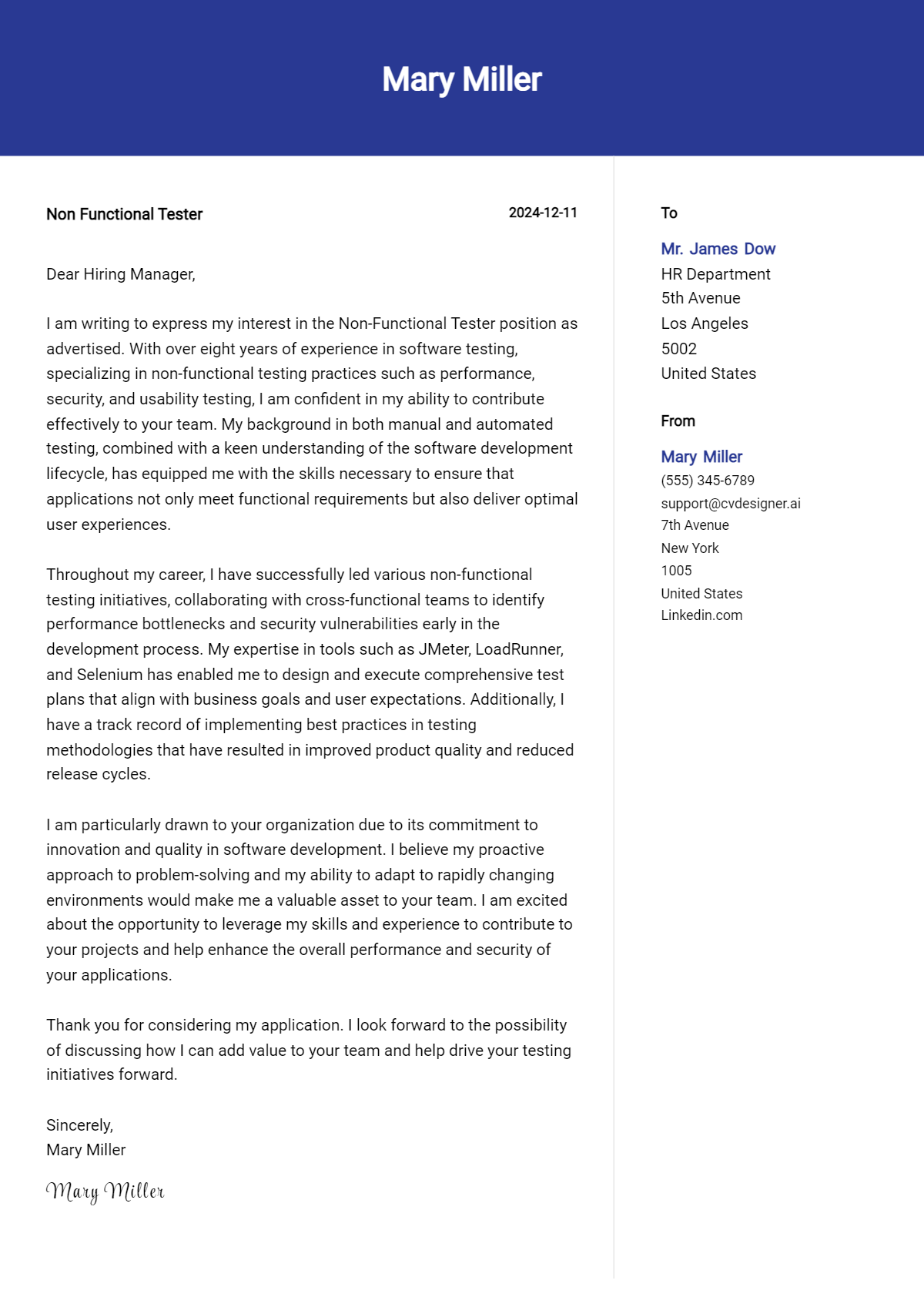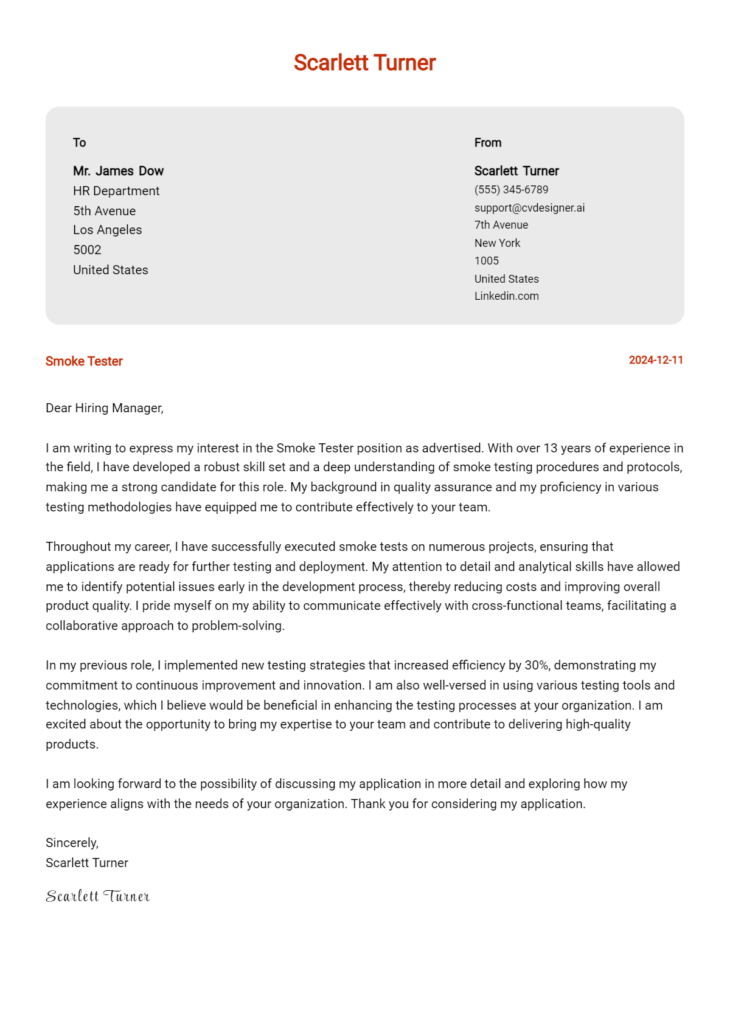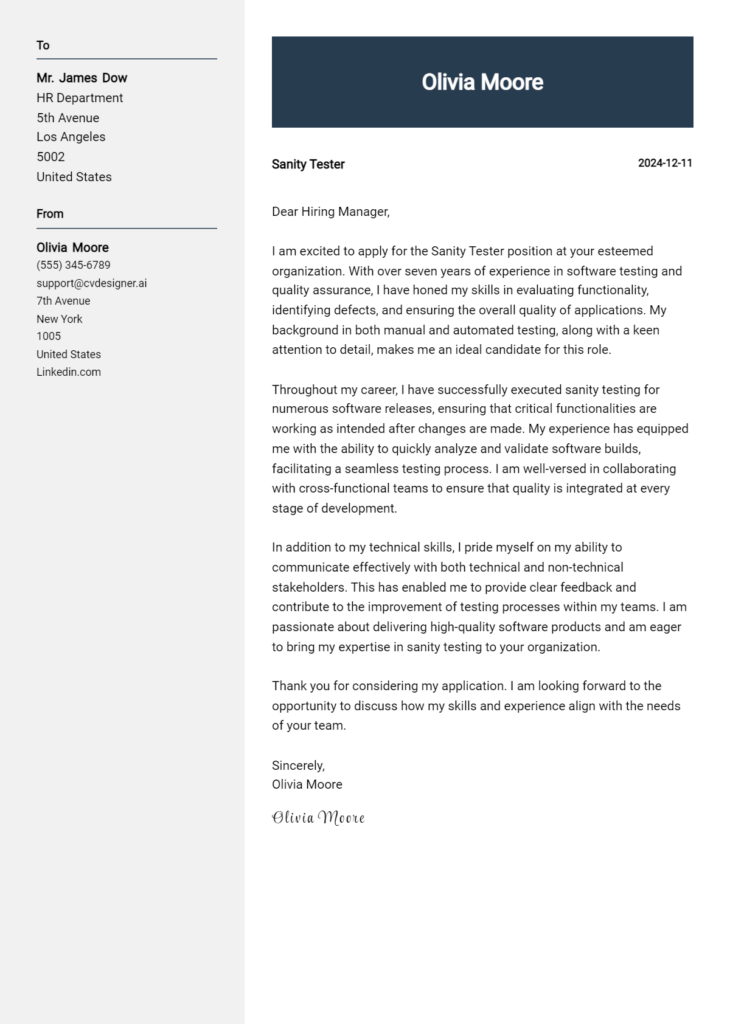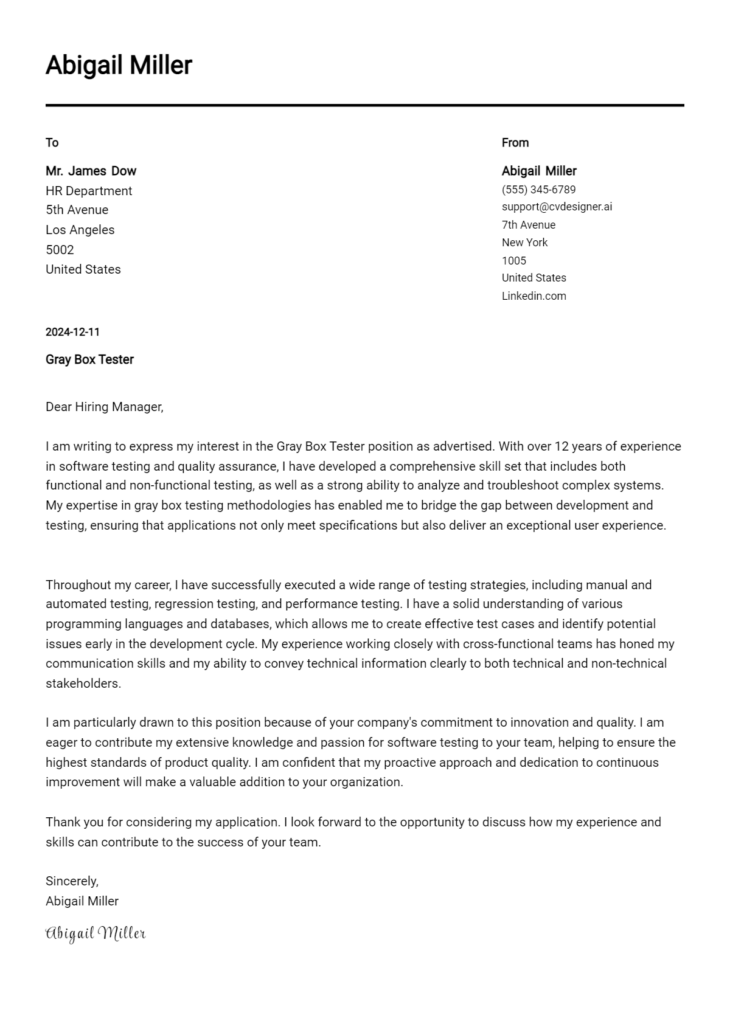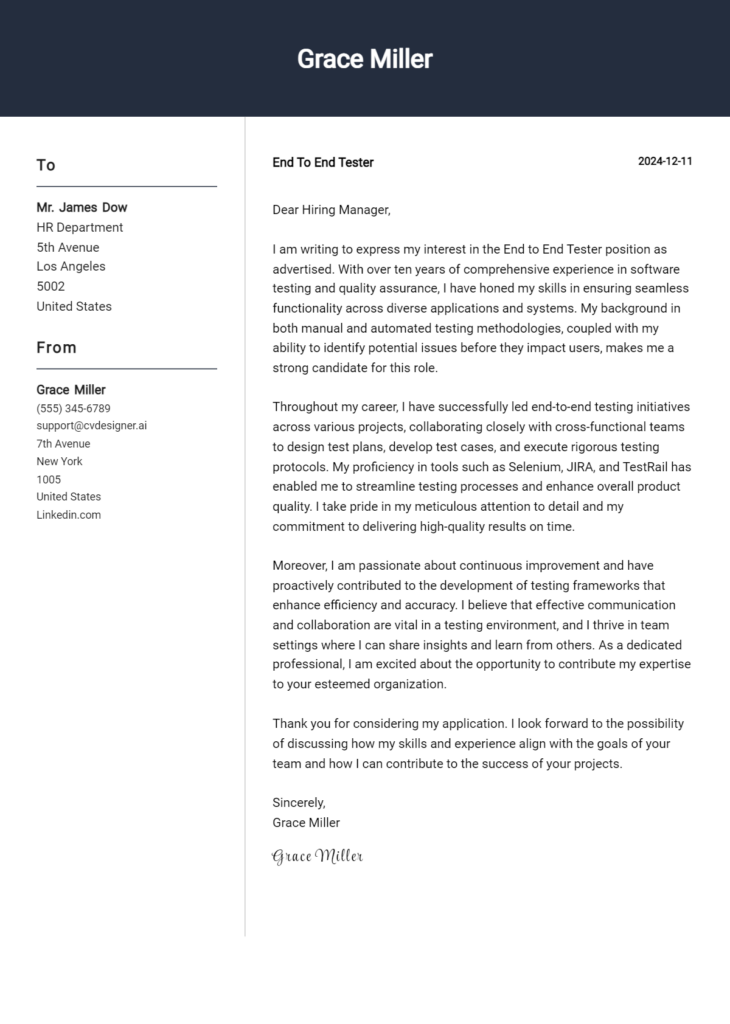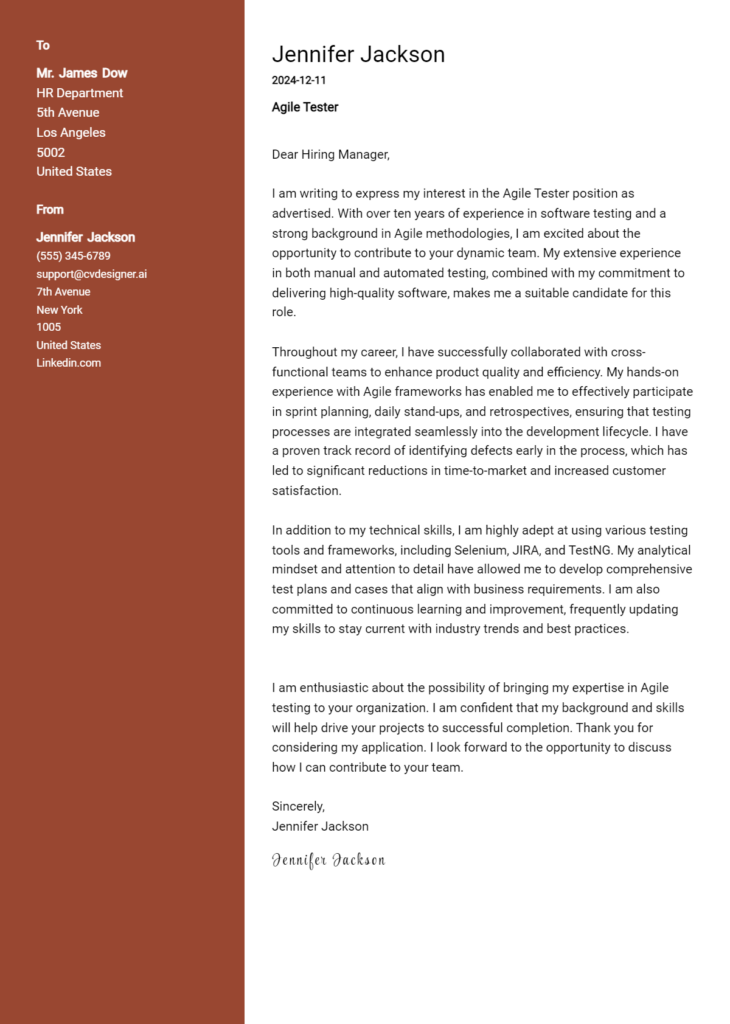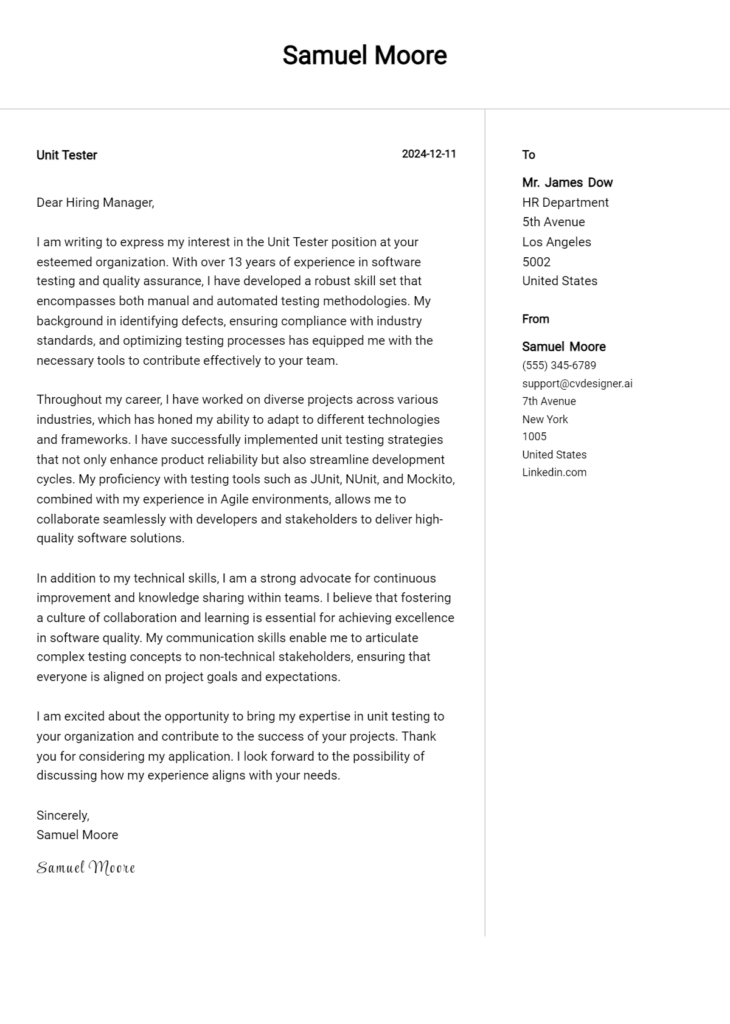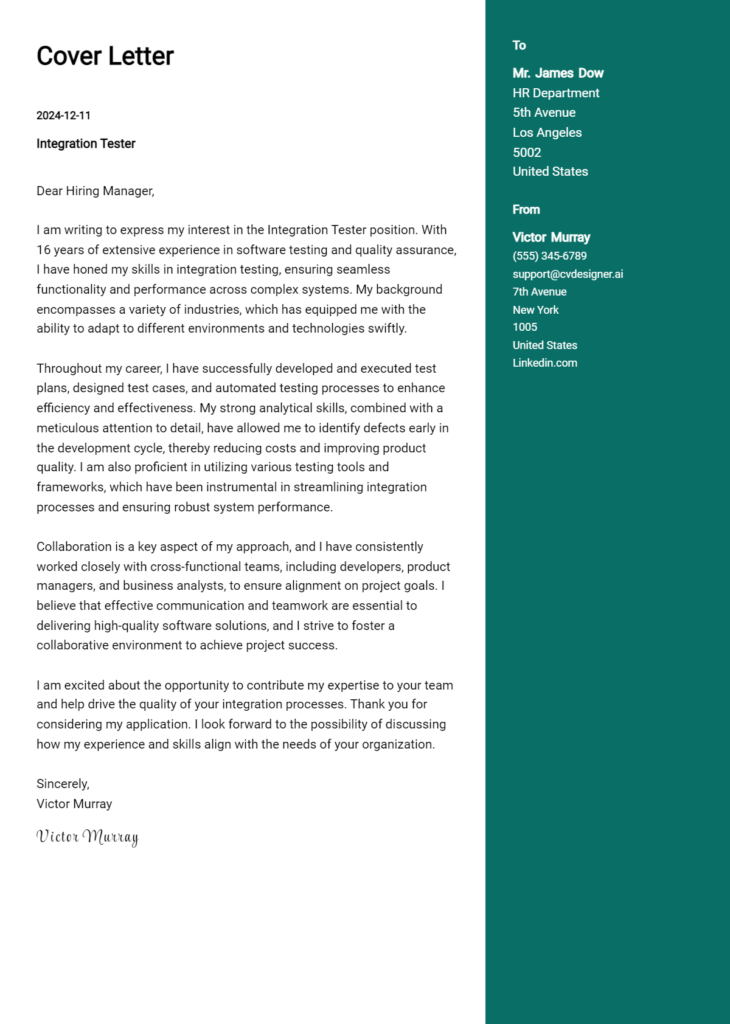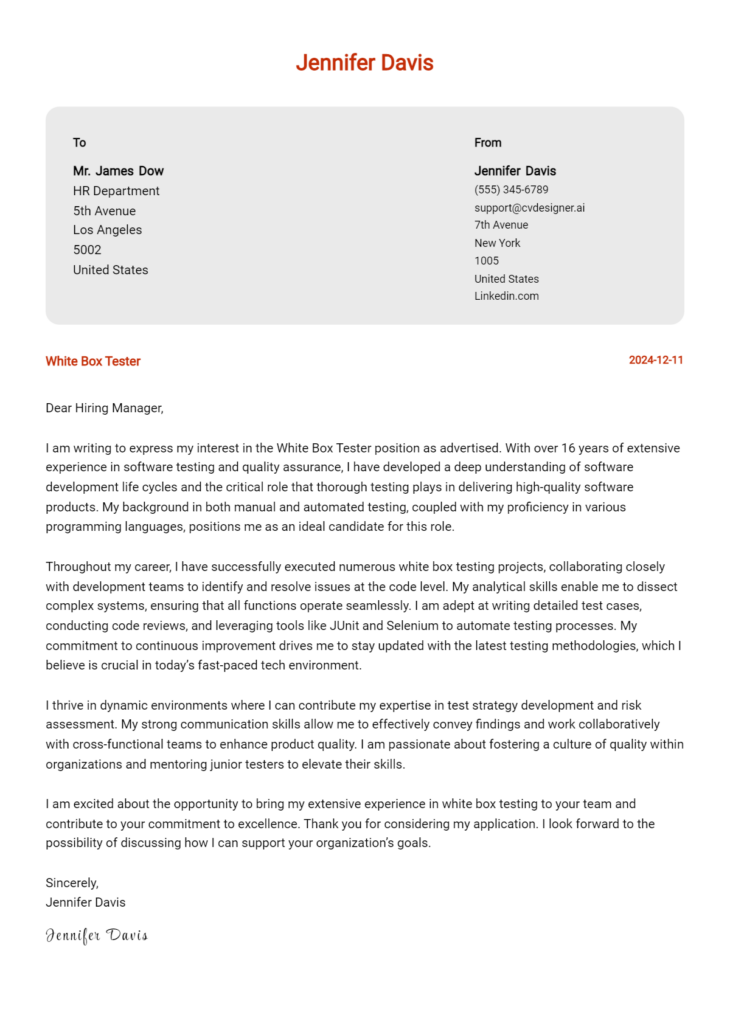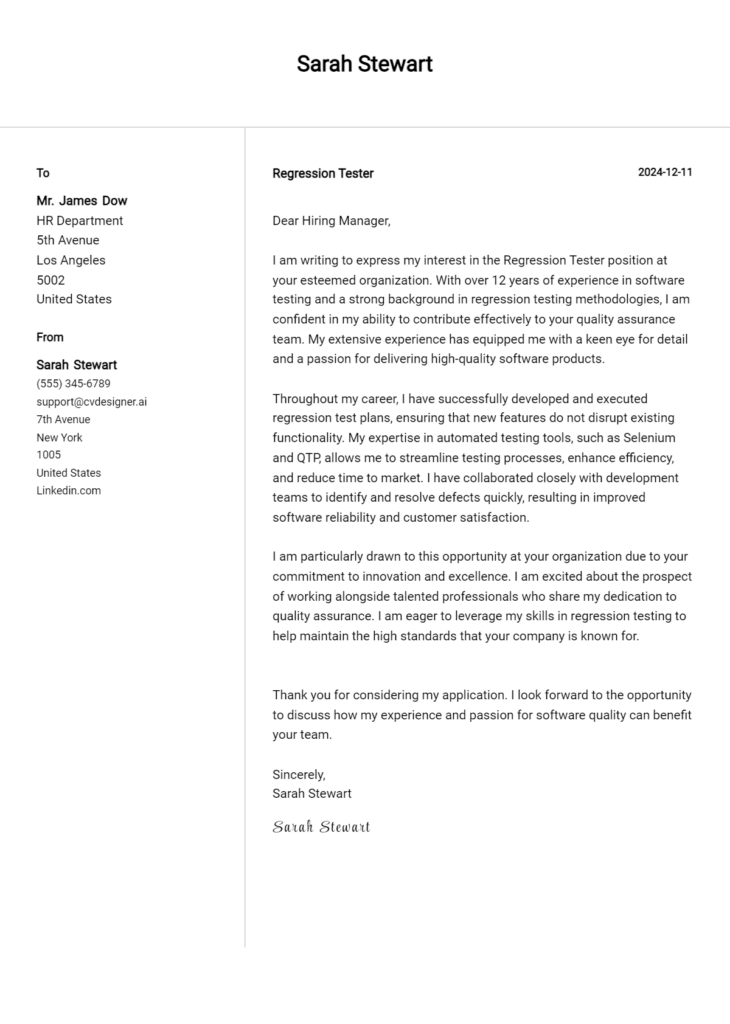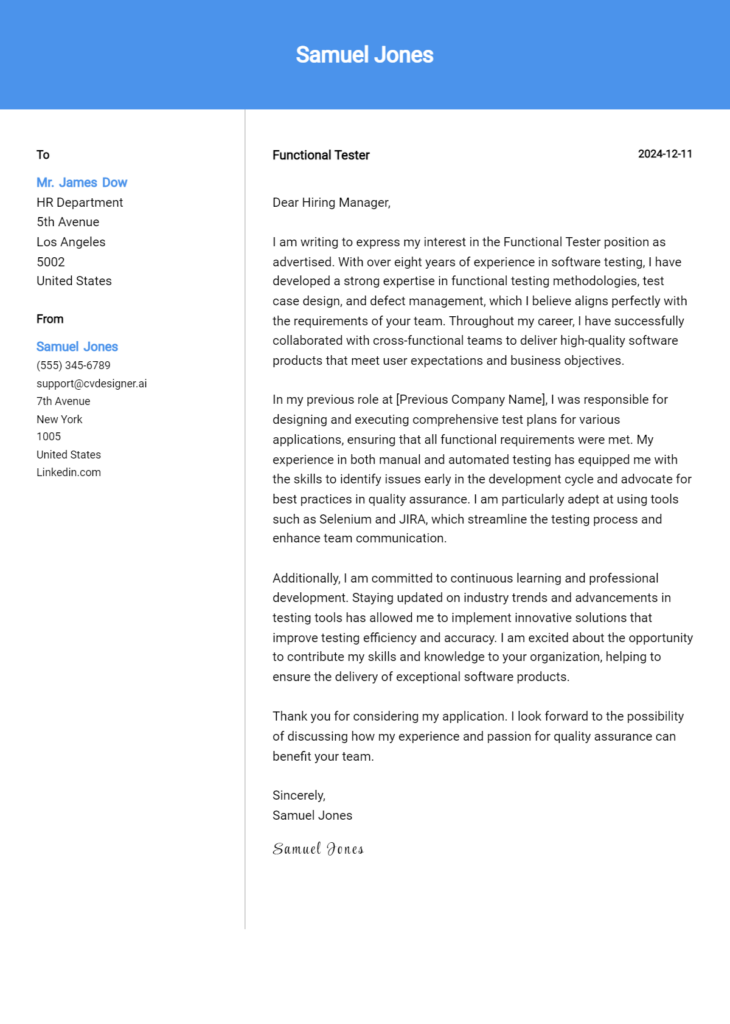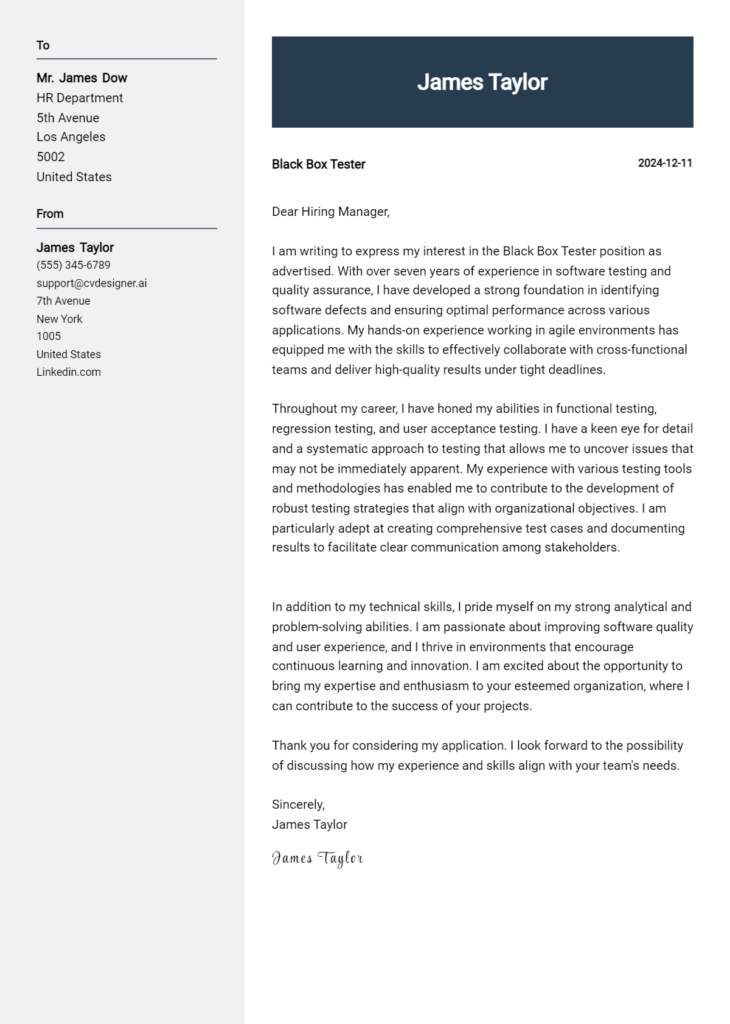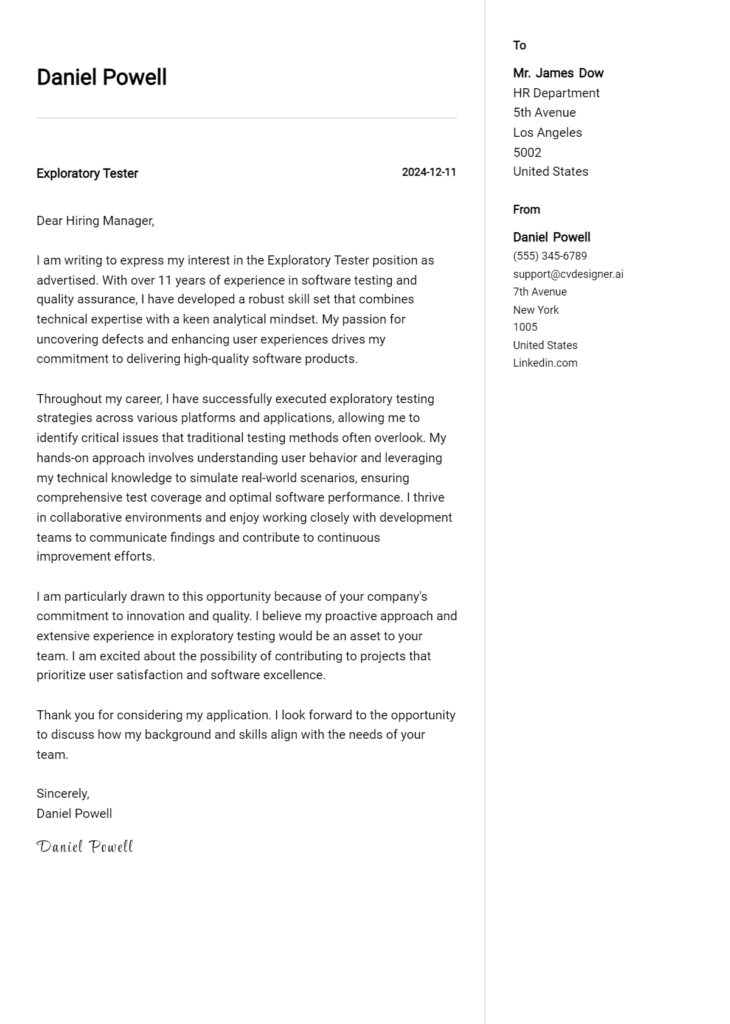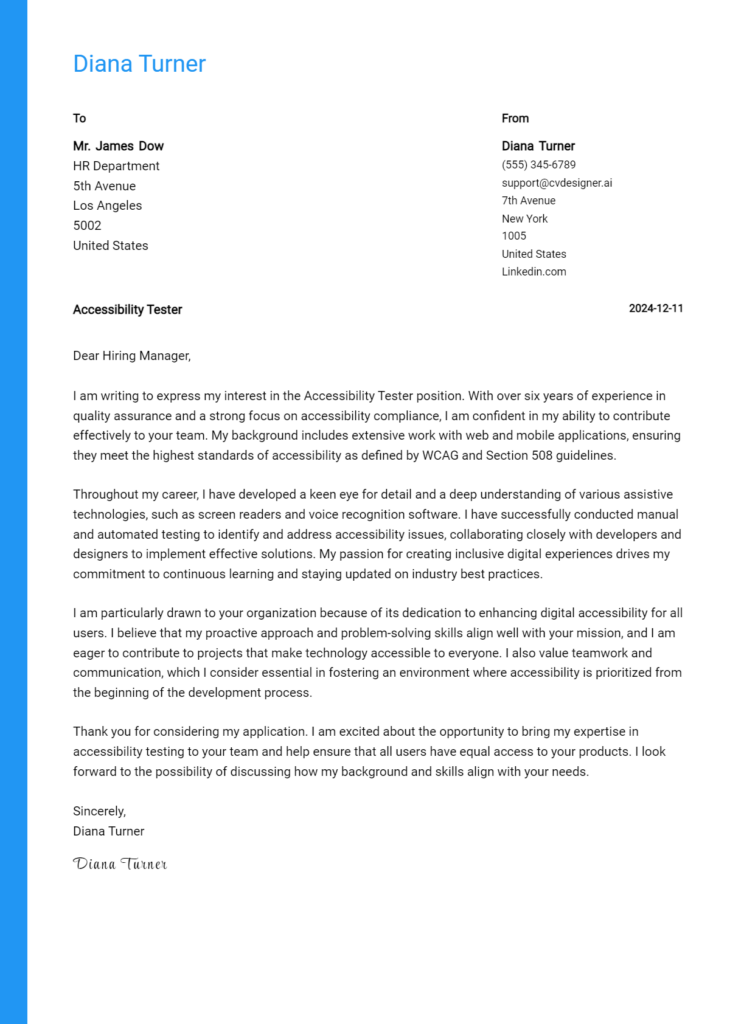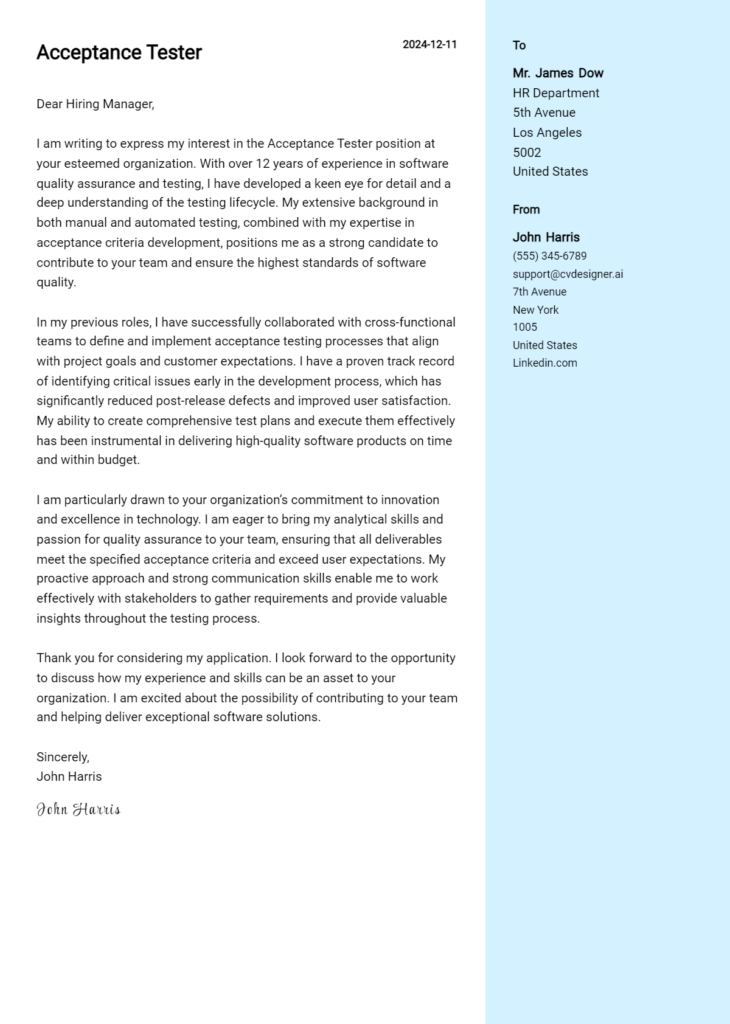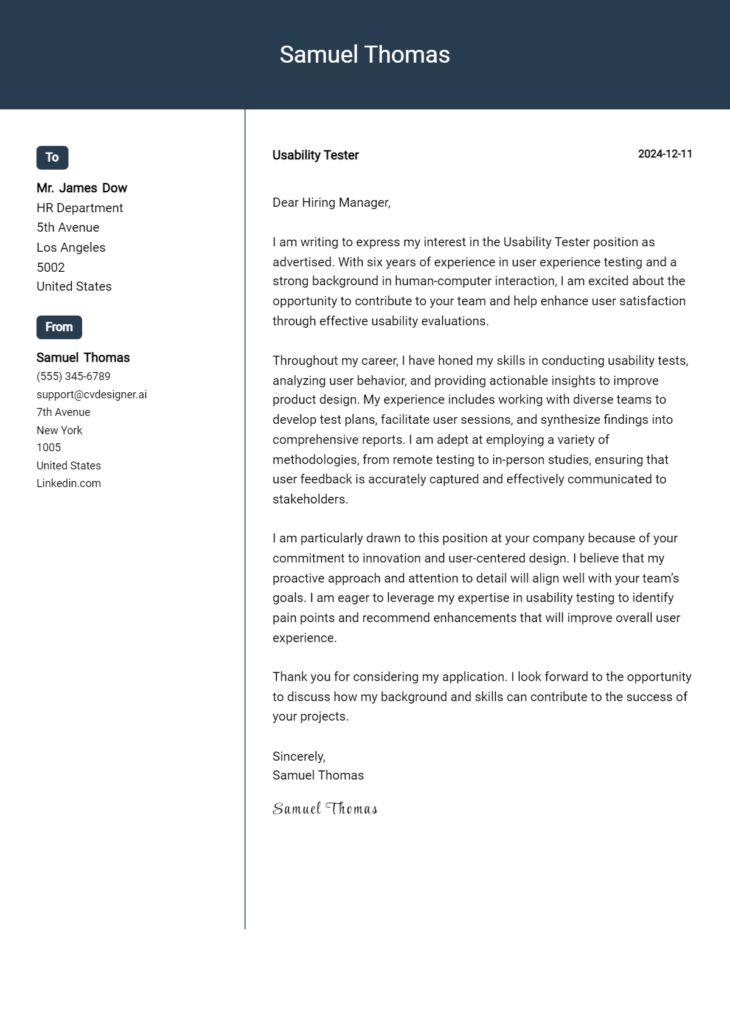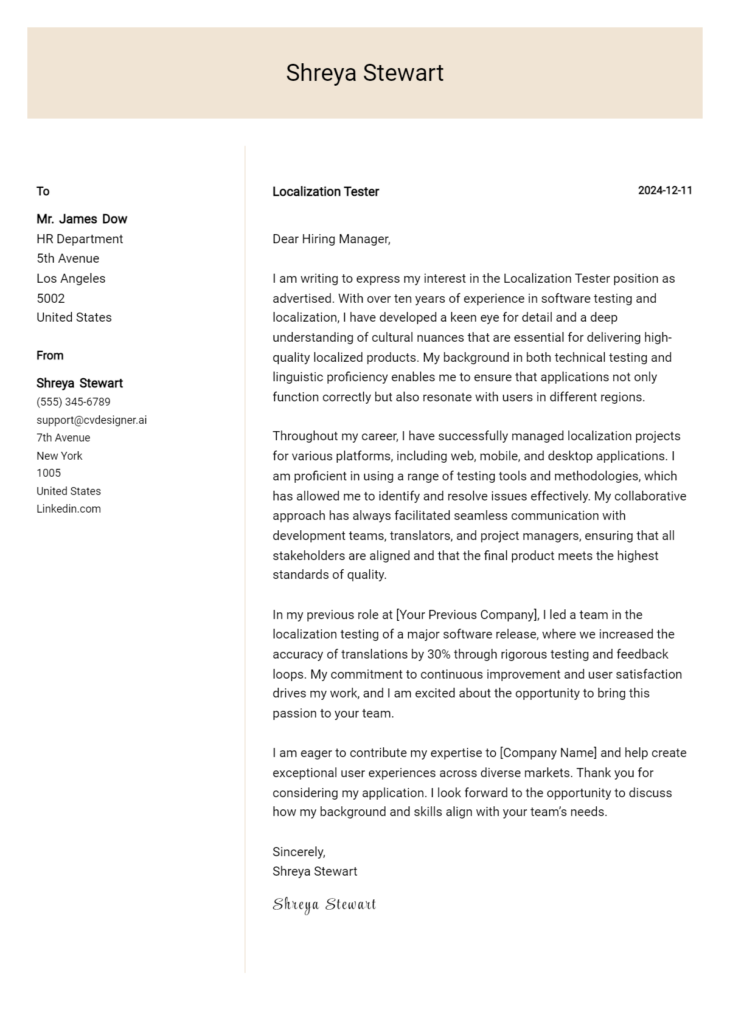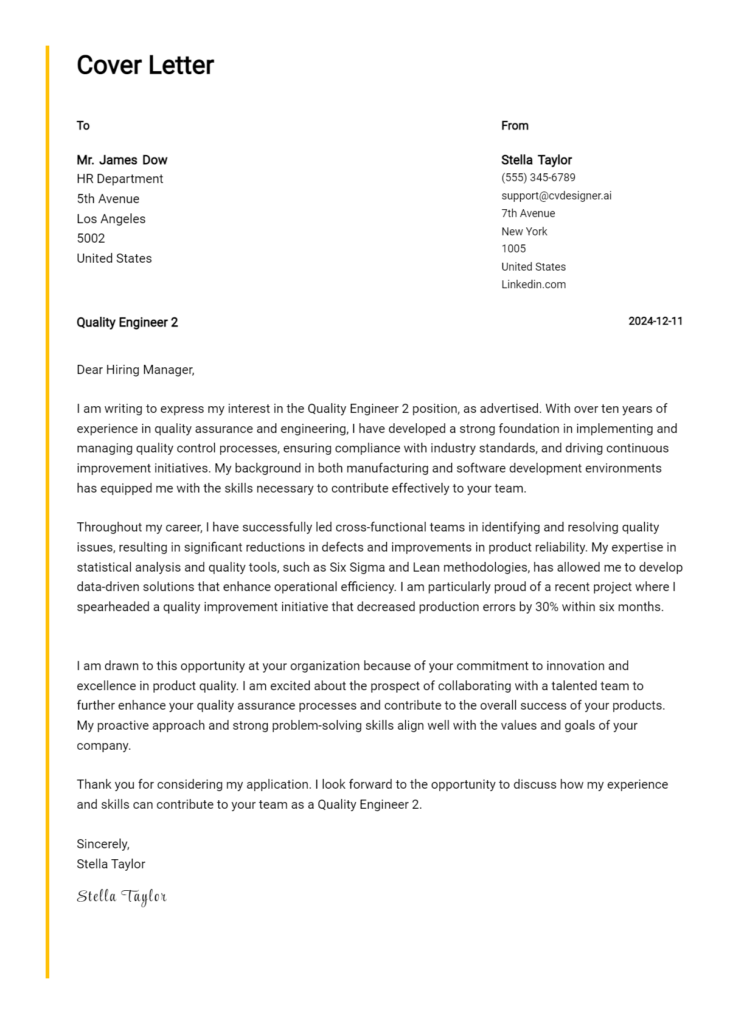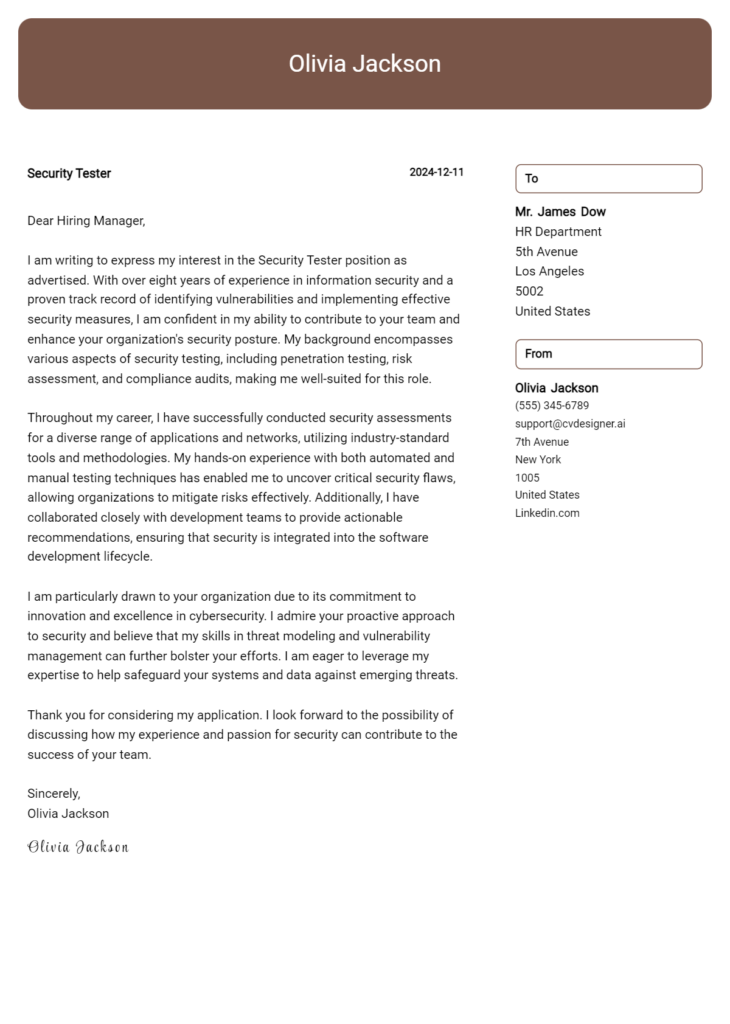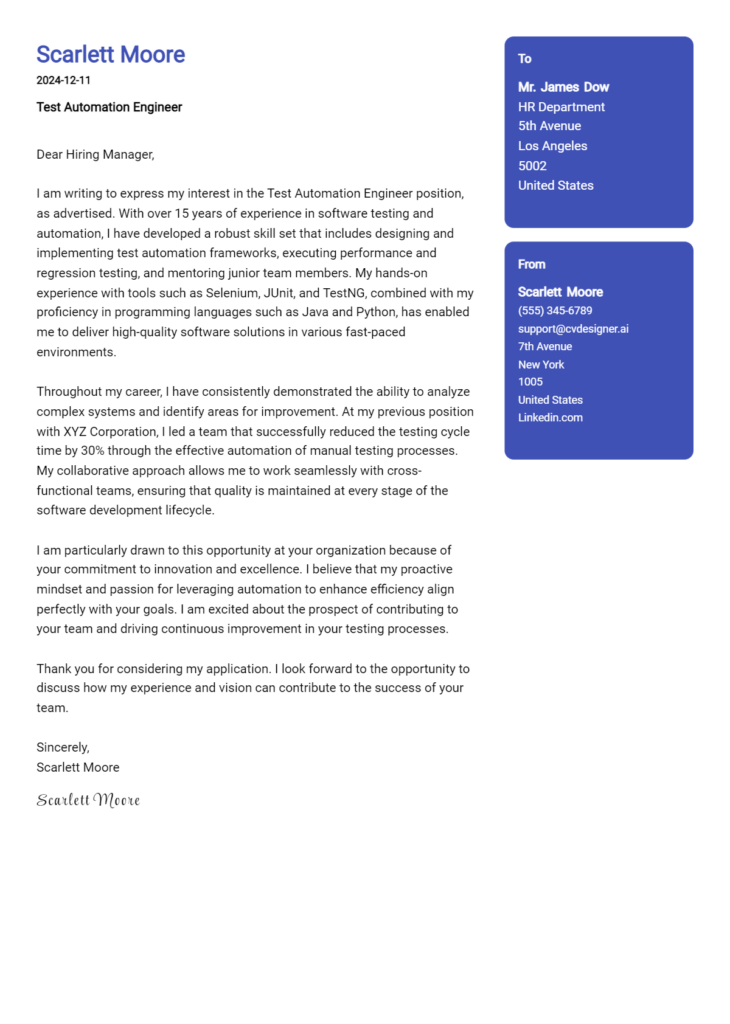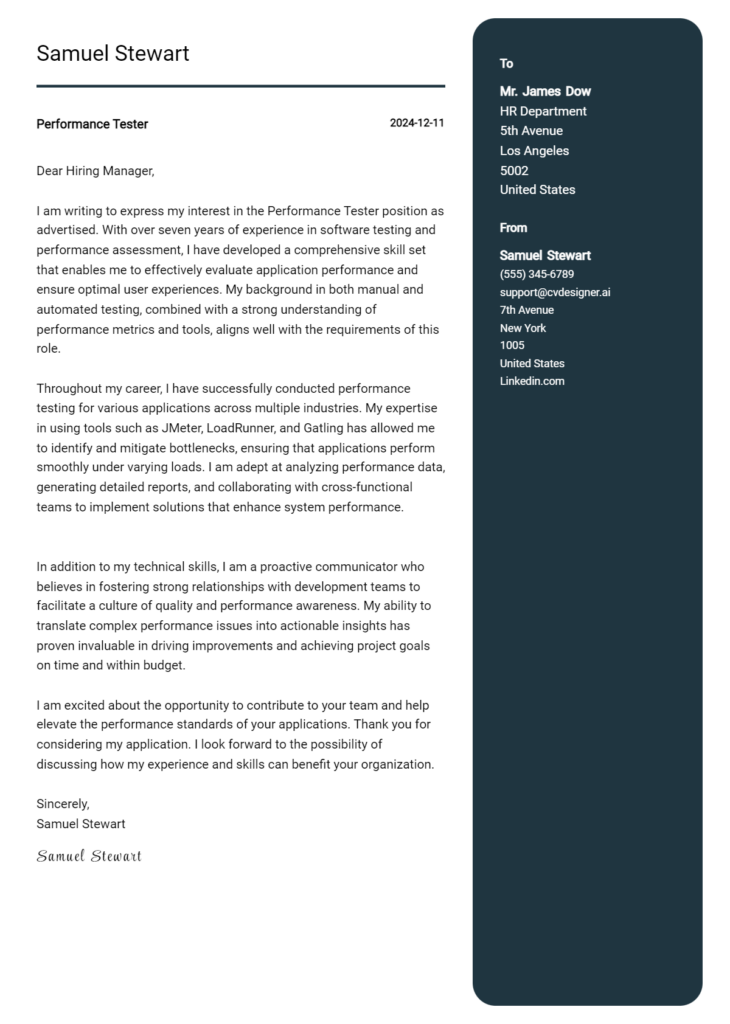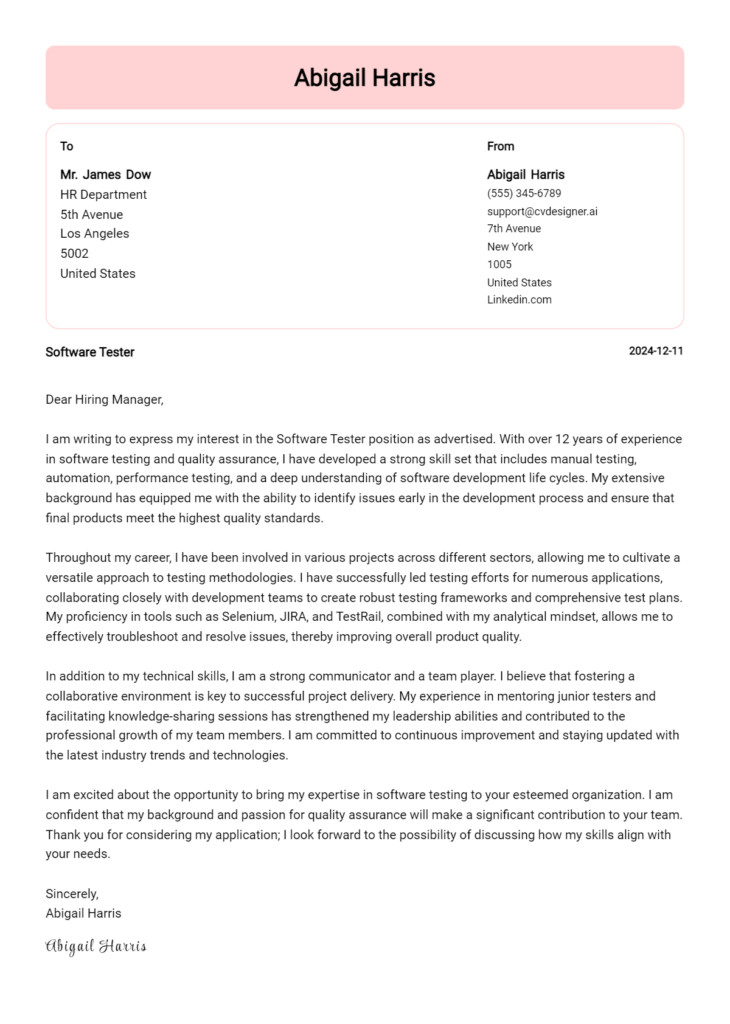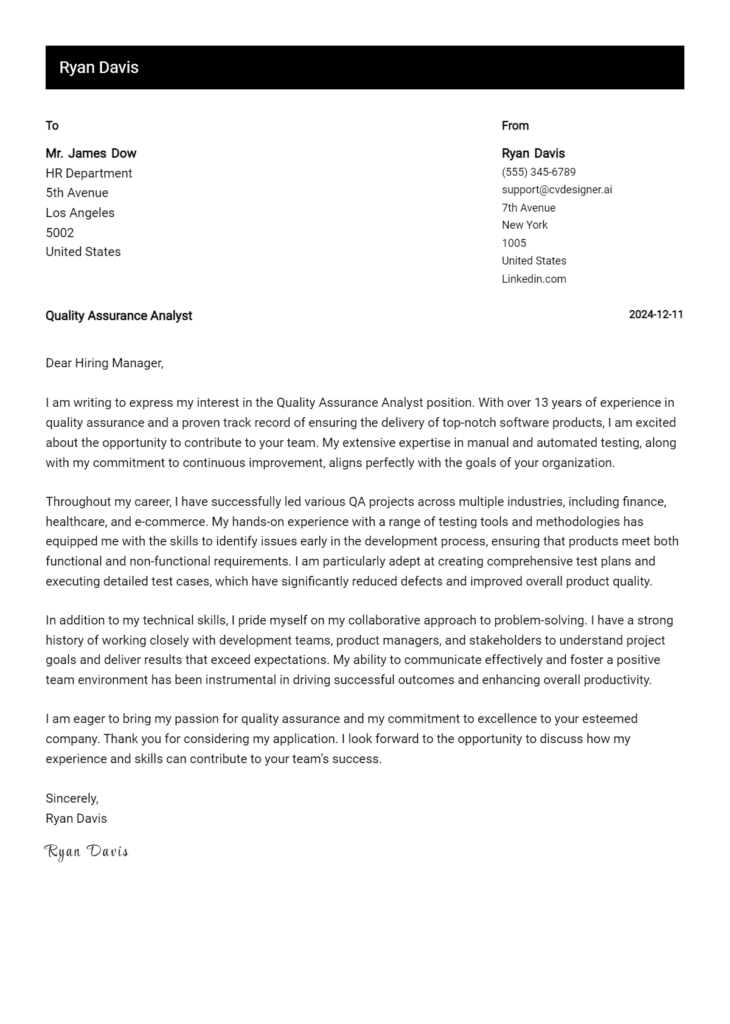Non Functional Tester Cover Letter Examples
Explore additional Non Functional Tester cover letter samples and guides and see what works for your level of experience or role.
How to Format a Non-Functional Tester Cover Letter?
Crafting a well-structured cover letter is essential for a Non-Functional Tester, as it underscores your meticulous nature and ability to evaluate systems beyond functional requirements. The way you format your cover letter not only showcases your communication skills but also highlights your understanding of quality assurance principles—critical traits in non-functional testing. A polished and organized cover letter can capture the attention of hiring managers, demonstrating your readiness to tackle performance, security, and usability challenges.
In this guide, we'll outline the key components of an effective cover letter, providing insights and examples tailored for the Non-Functional Testing field.
We'll focus on the essential elements of a professional cover letter, including:
- Cover Letter Header
- Cover Letter Greeting
- Cover Letter Introduction
- Cover Letter Body
- Cover Letter Closing
Each section serves a significant purpose in emphasizing your qualifications and professionalism. Let’s delve into each part and learn how to make your Non-Functional Tester cover letter truly stand out.
Importance of the Cover Letter Header for a Non-Functional Tester
The cover letter header is a crucial component of any job application, including that of a Non-Functional Tester. It sets the tone for the rest of the document and provides essential information that helps create a positive first impression. A well-structured header should include your contact information, the date, and the recipient's details, ensuring clarity and professionalism. This organization not only reflects your attention to detail—an important skill for a tester—but also makes it easier for hiring managers to contact you. Below are examples of a strong and weak cover letter header.
Strong Example
John Doe 123 Testing Lane Quality City, QC 12345 johndoe@email.com (123) 456-7890 October 1, 2023 Jane Smith Hiring Manager Tech Solutions Inc. 456 Innovation Ave. Tech Town, TT 67890
Weak Example
johndoe@email.com Tech Solutions Inc. October 1
The Importance of a Cover Letter Greeting
The greeting of a cover letter serves as the first point of contact between the applicant and the hiring manager, setting the tone for the entire message. A well-crafted greeting not only demonstrates professionalism but also adds a personal touch by addressing the recipient directly. By avoiding generic salutations and taking the time to research the hiring manager's name, candidates can convey their sincere interest in the role and organization. Personalization shows that the applicant has invested effort into understanding the company, making a strong first impression.
When crafting a greeting, it's essential to strike the right balance between formality and approachability. Here are some examples of strong and weak greetings for a Non-Functional Tester cover letter:
Strong Greeting Example
Dear [Hiring Manager's Name],
Weak Greeting Example
To Whom It May Concern,
The Importance of a Strong Cover Letter Introduction for a Non-Functional Tester
A well-crafted cover letter introduction is crucial for a Non-Functional Tester, as it serves as the first impression a candidate makes on a hiring manager. This introduction should be engaging enough to capture attention, express genuine interest in the role, and highlight key skills or notable achievements that make the candidate a strong fit for the position. A powerful introduction sets the tone for the rest of the cover letter, encouraging the reader to learn more about the applicant’s qualifications. Below are examples of both strong and weak cover letter introductions for a Non-Functional Tester.
Strong Example
Dear [Hiring Manager's Name], I am excited to apply for the Non-Functional Tester position at [Company Name], where my extensive experience in performance testing and my passion for ensuring software reliability can significantly contribute to your team. With a track record of improving application performance by over 30% through rigorous testing methodologies and keen analytical skills, I am eager to leverage my expertise to deliver exceptional user experiences and enhance product quality at [Company Name].
Weak Example
To Whom It May Concern, I am writing to apply for the Non-Functional Tester job. I have some experience in testing, and I think I would be okay at the job. I hope you consider my application.
Purpose of the Cover Letter Body for a Non-Functional Tester
The cover letter body for a Non-Functional Tester serves as a critical platform for candidates to articulate their skills and experiences in relation to the specific demands of the role. It allows applicants to highlight their expertise in assessing the performance, usability, reliability, and scalability of software applications, which are essential aspects of non-functional testing. By detailing specific projects or accomplishments, candidates can effectively demonstrate their value to the company, illustrating how their contributions can lead to improved product quality and user satisfaction. A well-crafted cover letter body not only showcases technical proficiency but also reflects the candidate's understanding of the company's goals and how they align with their own professional journey.
Strong Example
Dear Hiring Manager, I am excited to apply for the Non-Functional Tester position at your esteemed organization. In my previous role at XYZ Corp, I successfully led a performance testing initiative for a high-traffic e-commerce application, which resulted in a 30% improvement in load times and a 15% increase in user retention. My experience with tools such as JMeter and LoadRunner, combined with my ability to analyze complex data, has equipped me with the skills necessary to ensure that applications not only meet functional requirements but also deliver optimal user experiences. I am eager to bring my expertise in non-functional testing to your team and contribute to enhancing your software's performance and reliability. Sincerely, [Your Name]
Weak Example
Dear Hiring Manager, I am writing to express my interest in the Non-Functional Tester position. I have done some testing work in the past and I think I can do a good job. I know a few tools and I am generally good with computers. I haven't worked on any specific projects that improved performance, but I am willing to learn. I hope you consider my application. Best, [Your Name]
Cover Letter Closing for Non-Functional Tester
The closing paragraph of a cover letter is crucial as it serves to reinforce the candidate's qualifications, express enthusiasm for the role, and prompt the employer to take the next steps, such as reviewing the resume or scheduling an interview. A strong closing not only summarizes the key skills and experiences that make the candidate a suitable fit for the Non-Functional Tester position but also leaves a lasting impression of professionalism and eagerness. Conversely, a weak closing may come off as disinterested or vague, which can diminish the overall impact of the application.
Strong Example
Thank you for considering my application for the Non-Functional Tester position at [Company Name]. With my extensive experience in performance testing and a keen eye for detail, I am excited about the opportunity to contribute to your team. I believe my skills align perfectly with your needs, and I am eager to bring my expertise to ensure the highest quality of your products. I look forward to the possibility of discussing my application further and am available for an interview at your earliest convenience. Please feel free to review my resume for additional insights into my qualifications.
Weak Example
Thanks for reading my letter. I hope you think about my application. I guess I'm okay for the Non-Functional Tester job. It would be nice to talk more, but I’m not sure when I’ll be free. Please look at my resume if you want.
These tips are designed to help candidates craft an effective cover letter for a Non-Functional Tester position. A well-written cover letter can set you apart from other applicants by highlighting your technical skills, problem-solving abilities, understanding of the Software Development Life Cycle (SDLC), teamwork experience, and passion for continuous learning. By showcasing these qualities, you can demonstrate your fit for the role and your potential contribution to the team.
Tips for Writing an Effective Non-Functional Tester Cover Letter
Showcase Your Technical Skills: Clearly outline your technical expertise relevant to non-functional testing, such as performance testing, load testing, and security testing. Include specific tools and technologies you are proficient in, like JMeter, LoadRunner, or Selenium. Mention any certifications or training that support your qualifications. This is crucial for demonstrating your readiness to tackle the challenges of the role.
Highlight Problem-Solving Abilities: Provide examples of past experiences where you successfully identified and resolved issues related to non-functional aspects of applications. Use metrics to illustrate your impact, such as improved load times or reduced error rates. Employers value candidates who can think critically and address challenges effectively.
Demonstrate Your Understanding of the SDLC: Discuss your familiarity with the Software Development Life Cycle and how non-functional testing fits into it. Mention your experience in collaborating with development and QA teams to integrate testing at various stages of the SDLC. This will reflect your holistic understanding of the development process and emphasize your ability to work well within a team.
Emphasize Teamwork and Collaboration: Non-functional testing often requires collaboration with cross-functional teams. Highlight your experience working in agile environments or with diverse teams. Share specific examples of how your collaboration led to improved product quality or process efficiency. This shows that you are a team player who values cooperation and communication.
Express a Passion for Continuous Learning: The field of software testing is constantly evolving, so it's essential to convey your commitment to staying updated with industry trends and new technologies. Mention any recent courses, workshops, or conferences you've attended. Showcasing your enthusiasm for continuous improvement will signal to employers that you are proactive and eager to grow in your career.
By following these tips, you can create a compelling cover letter that captures the attention of hiring managers. For additional guidance, consider exploring cover letter templates or utilizing a cover letter builder to streamline your writing process.
Common Mistakes to Avoid in a Non-Functional Tester Cover Letter
Crafting an effective cover letter is essential for making a strong first impression as a Non-Functional Tester. Avoiding common pitfalls can significantly enhance your chances of securing an interview. Here are some frequent mistakes and tips on how to circumvent them:
Generic Content: Using a one-size-fits-all cover letter can be detrimental. Tailor your letter to the specific job and company by referencing the job description and aligning your skills with their requirements.
Lack of Specific Examples: Failing to provide concrete examples of your non-functional testing experience can weaken your application. Highlight relevant projects or achievements that demonstrate your expertise in performance, security, or usability testing.
Ignoring the Format: A poorly structured cover letter can detract from your message. Ensure you follow a clear cover letter format that includes a strong opening, body, and closing to present your qualifications effectively.
Overly Technical Language: While technical knowledge is important, using jargon excessively can alienate hiring managers. Strive for clarity by balancing technical terms with accessible language.
Neglecting Soft Skills: Non-Functional Testing often requires collaboration and communication. Highlight your soft skills, such as teamwork and problem-solving, to show that you can work effectively in a team environment.
Ignoring Proofreading: Spelling and grammatical errors can undermine your professionalism. Carefully proofread your cover letter or use tools to check for errors before submitting.
Failing to Show Enthusiasm: A lack of passion for the role can be a red flag. Convey your enthusiasm for the position and the company, making it clear why you want to be a part of their team.
By avoiding these common mistakes, you can create a compelling cover letter that stands out. For inspiration, check out these cover letter examples to see how to effectively convey your qualifications.
Cover Letter FAQs for Non-Functional Tester
What should I include in my cover letter for a Non-Functional Tester position?
In your cover letter, start by introducing yourself and specifying the position you are applying for. Highlight your relevant experience in non-functional testing, such as performance, load, and stress testing. Mention specific tools and methodologies you have used, like JMeter or LoadRunner. Discuss your understanding of non-functional requirements and how you've successfully ensured software meets these criteria in past projects. It's also beneficial to include examples of how your testing has positively impacted project outcomes. Finally, express your enthusiasm for the role and the company, showing that you have researched their work and values.
How can I demonstrate my skills in non-functional testing in my cover letter?
To effectively demonstrate your skills in non-functional testing, use concrete examples from your work experience. Discuss specific projects where you’ve applied non-functional testing techniques, detailing the challenges faced and how you overcame them. Include metrics or results if possible, such as improved application response times or successful load handling during peak usage. Mention any certifications or training relevant to non-functional testing, such as ISTQB or specific tool training. Additionally, emphasize your analytical skills and attention to detail, which are crucial for identifying performance bottlenecks and usability issues.
How do I tailor my cover letter for a specific Non-Functional Tester job?
Tailoring your cover letter involves aligning your experiences and skills with the specific requirements mentioned in the job description. Start by analyzing the job listing to identify key qualifications and responsibilities. Make sure to address these points directly in your cover letter. For instance, if the job emphasizes the importance of automated testing, mention your experience with automation tools and how you've implemented them in previous roles. Use the company’s language and values in your writing to show you understand their culture. Personalizing your cover letter increases your chances of standing out to hiring managers.
Should I include technical jargon in my cover letter?
While it’s important to communicate your technical expertise, be cautious with the use of jargon. Aim for a balance that showcases your knowledge without overwhelming the reader. Use technical terms that are relevant to the job, but ensure they are widely understood and pertinent to the role. For instance, mentioning specific non-functional testing types, tools, and methodologies can demonstrate your expertise. However, ensure that you explain any complex terms or concepts in a way that makes them accessible. This approach not only reflects your technical skills but also your ability to communicate effectively with both technical and non-technical stakeholders.
Build your Cover Letter in minutes
Use an AI-powered cover letter builder and have your letter done in 5 minutes. Just select your template and our software will guide you through the process.

